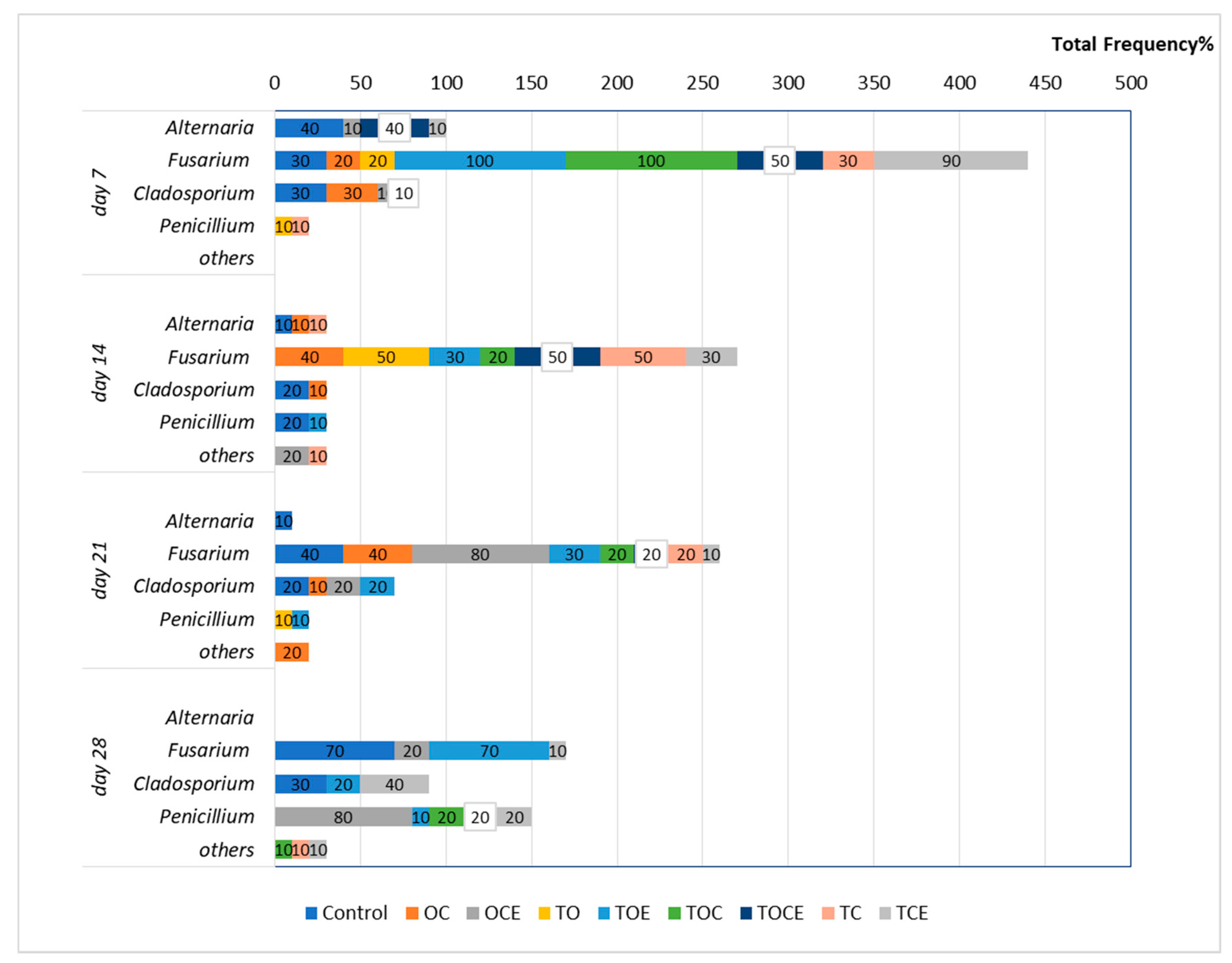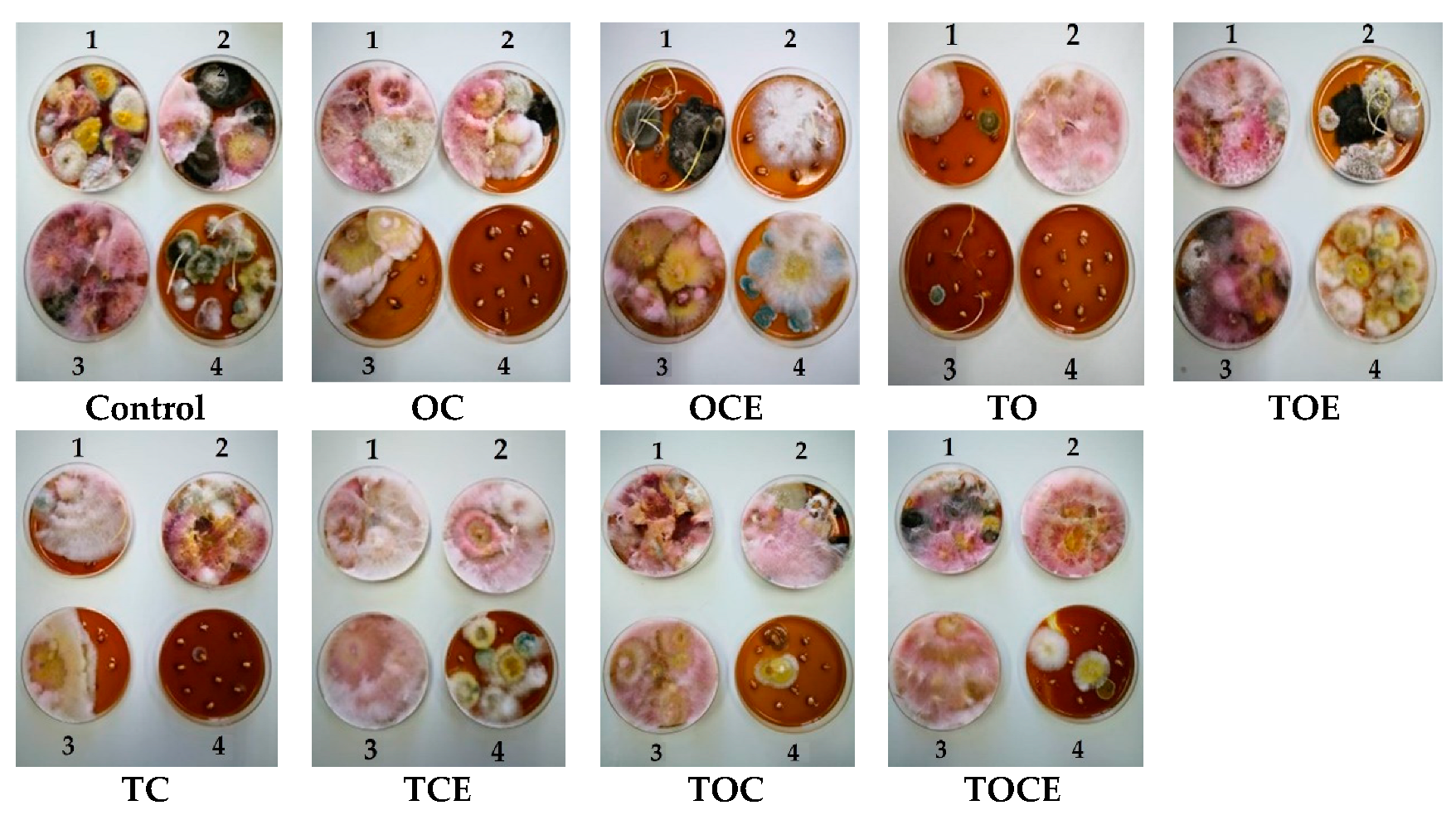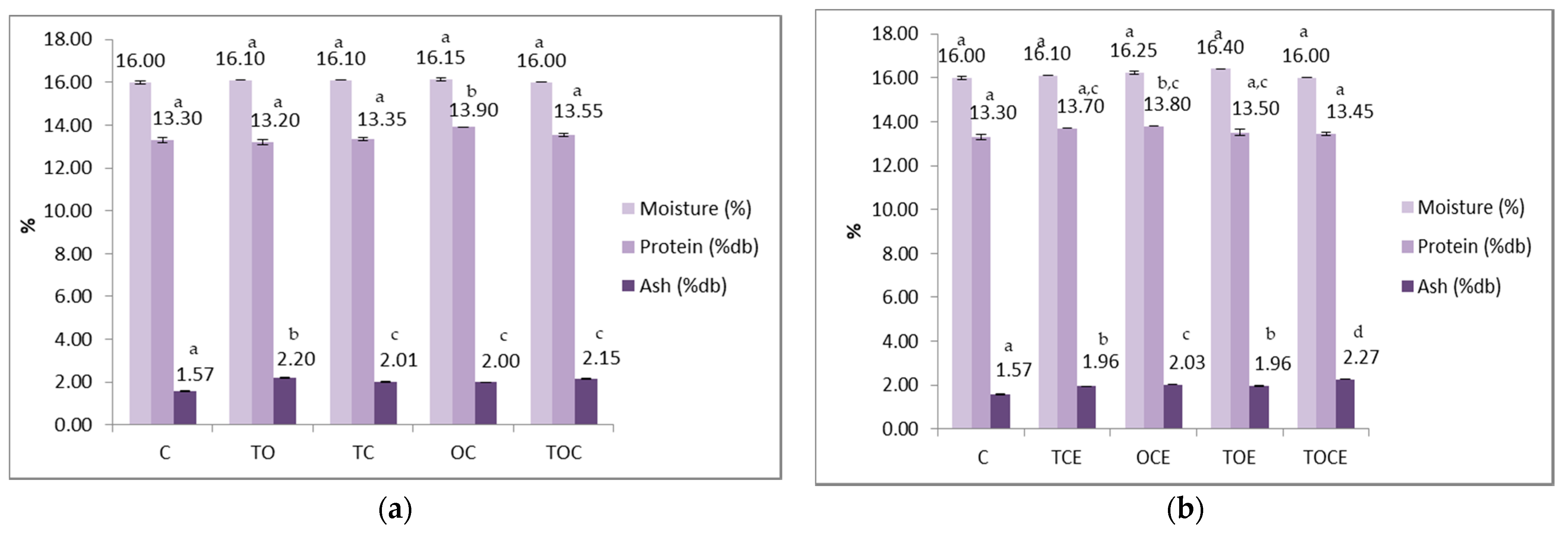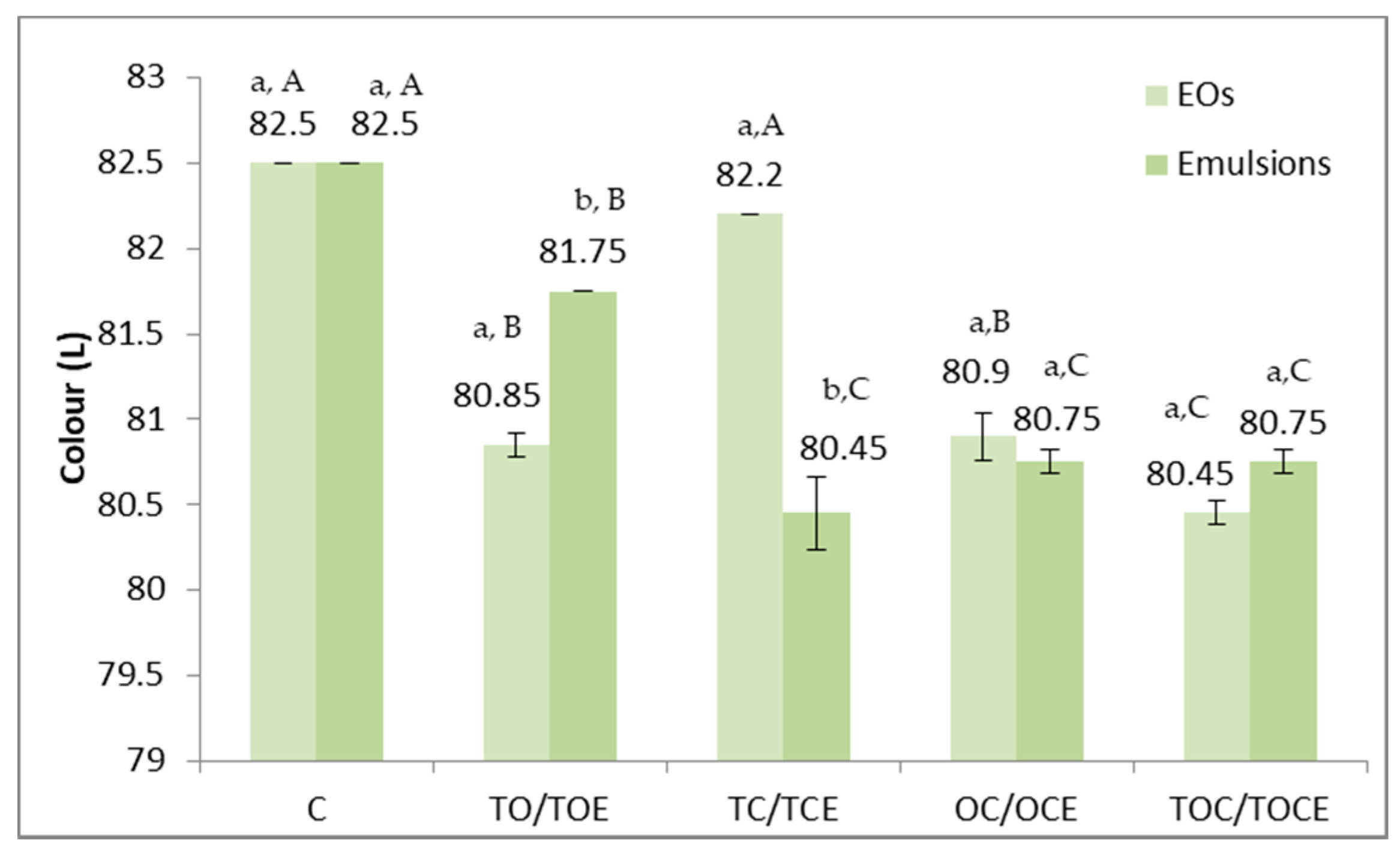Natural Emulsions Based on Essential Oils as Antifungal and Antimycotoxicogenic Agents on Wheat for Bakery Industry
Abstract
1. Introduction
2. Materials and Method
2.1. The Obtaining of EO Mixtures and Natural Preparations
2.2. Chemical Composition of EO Mixtures
2.3. Preparation and Characterisation of Natural Emulsions
2.4. Establishing the Minimum Concentration with Impact on Mycelial Growth of Fungi
- RM—radius of the mycelial surface.
- IIS—initial inoculated surface.
2.5. Treatment of Wheat Seeds
2.6. Analysis of Fungal Contamination
- NG = number of genera.
- TNF = total number of fungi in the sample.
2.7. Analysis of Mycotoxin Content
- IC—initial DON content in wheat seed without treatment (ppm).
- FC—final DON content in wheat seed after treatment with different EO mixtures and natural preparations (ppm).
2.8. Physical–Chemical Analysis of Wheat Seeds
2.9. Statistical Analysis
3. Results
3.1. Chemical Composition of EO Mixtures
3.2. Physical Characterisation of Natural Preparations
3.3. Fungal Contamination
3.4. Minimum Concentration with Impact on Mycelial Growth of Fungi
3.5. DON Mycotoxin Content
3.6. Physical–Chemical Analysis of Wheat Seeds
3.7. Correlations
4. Discussions
4.1. Chemical Composition of EO Mixtures
4.2. Physical Characterisation of Natural Emulsions Based on EOs
4.3. Antifungal and Antimicotoxicogenic Potential of EO Mixtures and Emulsions
4.4. Physical–Chemical Analysis of Wheat Seeds
5. Conclusions
Author Contributions
Funding
Data Availability Statement
Acknowledgments
Conflicts of Interest
References
- Jajic, I.; Jurić, V.; Glamocic, D.; Abramović, B. Occurrence of Deoxynivalenol in Maize and Wheat in Serbia. Int. J. Mol. Sci. 2008, 9, 2114–2126. [Google Scholar] [CrossRef] [PubMed]
- Willer, H.; Kilcher, L. (Eds.) The World of Organic Agriculture. Statistics and Emerging Trends; FiBL-IFOAM Report; Research Institute of Organic Agriculture FiBL and IFOAM-Organics International: Bonn, Germany, 2011. [Google Scholar]
- Pestka, J.J. Deoxynivalenol: Toxicity, mechanisms and animal health risks. Anim. Breed. Feed 2008, 137, 283–298. [Google Scholar] [CrossRef]
- Sumalan, R.-M.; Alexa, E.; Poiana, M.-A. Assessment of Inhibitory Potential of Essential Oils on Natural Mycoflora and Fusarium Mycotoxins Production in Wheat. Chem. Cent. J. 2013, 7, 32. [Google Scholar] [CrossRef]
- Stroia, C.; Tabuc, C.; Neacsu, A. Incidence of Fusarium species and its mycotoxins in cereals from western Romania. Res. J. Agric. Sci. 2010, 42, 302–309. [Google Scholar]
- Iqbal, S.Z.; Usman, S.; Razis, A.F.A.; Ali, N.B.; Saif, T.; Asi, M.R. Assessment of Deoxynivalenol in Wheat, Corn and Its Products and Estimation of Dietary Intake. Int. J. Environ. Res. Public Health 2020, 17, 5602. [Google Scholar] [CrossRef] [PubMed]
- Creppy, E.E. Update of survey, regulation and toxic effects of mycotoxins in Europe. Toxicol. Lett. 2002, 127, 19–28. [Google Scholar] [CrossRef]
- Knutsen, H.K.; Alexander, J.; Barregård, L.; Bignami, M.; Brüschweiler, B.; Ceccatelli, S.; Cottrill, B.; Dinovi, M.; Grasl-Kraupp, B.; Hogstrand, C.; et al. Risks to human and animal health related to the presence of deoxynivalenol and its acetylated and modified forms in food and feed. EFSA J. 2017, 15, 4718. [Google Scholar] [CrossRef]
- Kretschmer, M.; Leroch, M.; Mosbach, A.; Walker, A.-S.; Fillinger, S.; Mernke, D.; Schoonbeek, H.-J.; Pradier, J.-M.; Leroux, P.; De Waard, M.A.; et al. Fungicide-driven evolution and molecular basis of multidrug resistance in field populations of the grey mould fungus Botrytis cinerea. PLoS Pathog. 2009, 5, e1000696. [Google Scholar] [CrossRef]
- Jimenez Garcia, S.; Garcia-Mier, L.; Garcia-Trejo, J.; Ramirez-Gomez, X.; Guevara-Gonzalez, R.; Feregrino-Perez, A. Fusarium Mycotoxins and Metabolites that Modulate Their Production. In Fusarium-Plant Diseases, Pathogen Diversity, Genetic Diversity, Resistance and Molecular Markers; IntechOpen: London, UK, 2018; pp. 23–40. [Google Scholar] [CrossRef]
- Magan, N.; Hope, R.; Cairns, V.; Aldred, D. Post-harvest fungal ecology: Impact of fungal growth and mycotoxin accumulation in stored grain. Eur. J. Plant Pathol. 2003, 109, 723–730. [Google Scholar] [CrossRef]
- Sadat Razavi, M.; Golmohammadi, A.; Nematollahzadeh, A.; Ghanbari, A.; Davari, M.; Carullo, D.; Farris, S. Production of Innovative Essential Oil-Based Emulsion Coatings for Fungal Growth Control on Postharvest Fruits. Foods 2022, 11, 1602. [Google Scholar] [CrossRef]
- Khalifa, I.; Barakat, H.; El-Mansy, H.A.; Soliman, S.A. Preserving apple (Malus domestica var. Anna) fruit bioactive substances using olive wastes extract-chitosan film coating. Inf. Process. Agric. 2017, 4, 90–99. [Google Scholar] [CrossRef]
- Yuan, G.; Chen, X.; Li, D. Chitosan films and coatings containing essential oils: The antioxidant and antimicrobial activity, and application in food systems. Food Res. Int. 2016, 89, 117–128. [Google Scholar] [CrossRef]
- Sapper, M.; Palou, L.; Pérez-Gago, M.B.; Chiralt, A. Antifungal starch-gellan edible coatings with Thyme Essential oil for the post-harvest preservation of Apple and Persimmon. Coatings 2019, 9, 333. [Google Scholar] [CrossRef]
- Alexa, V.T.; Szuhanek, C.; Cozma, A.; Galuscan, A.; Borcan, F.; Obistioiu, D.; Dehelean, C.A.; Jumanca, D. Natural preparations based on orange, bergamot and clove essential oils and their chemical compounds as antimicrobial agents. Molecules 2020, 25, 5502. [Google Scholar] [CrossRef] [PubMed]
- Yudhistira, B.; Sulaimana, A.S.; Punthi, F.; Chang, C.-K.; Lung, C.-T.; Santoso, S.P.; Gavahian, M.; Hsieh, C.-W. Cold Plasma-Based Fabrication and Characterisation of Active Films Containing Different Types of Myristica fragrans Essential Oil Emulsion. Polymers 2022, 14, 1618. [Google Scholar] [CrossRef] [PubMed]
- Wang, Y.; Li, B.; Zhu, L.; Wang, P.; Xu, F.; Zhang, Y. Octenyl Succinic Acid Starch-Stabilized Vanilla Essential Oil Pickering Emulsion: Preparation, Characterization, Antioxidant Activity, and Storage Stability. Foods 2022, 11, 987. [Google Scholar] [CrossRef] [PubMed]
- Proto, M.R.; Biondi, E.; Baldo, D.; Levoni, M.; Filippini, G.; Modesto, M.; Di Vito, M.; Bugli, F.; Ratti, C.; Minardi, P.; et al. Essential Oils and Hydrolates: Potential Tools for Defense against Bacterial Plant Pathogens. Microorganisms 2022, 10, 702. [Google Scholar] [CrossRef]
- Milićević, Z.; Krnjajić, S.; Stević, M.; Ćirković, J.; Jelušić, A.; Pucarević, M.; Popović, T. Encapsulated Clove Bud Essential Oil: A New Perspective as an Eco-Friendly Biopesticide. Agriculture 2022, 12, 338. [Google Scholar] [CrossRef]
- Souza, A.G.; Ferreira, R.R.; de Oliveira, E.R.; Kato, M.M.; Mitra, S.K.; Rosa, D.d.S. Chemical Stabilization behind Cardamom Pickering Emulsion Using Nanocellulose. Polysaccharides 2022, 3, 200–216. [Google Scholar] [CrossRef]
- Haiying, C.; Chenghui, Z.; Changzhu, L.; Lin, L. Antibacterial mechanism of oregano essential oil. Ind. Crops Prod. 2019, 139, 111498. [Google Scholar] [CrossRef]
- Basilico, M.Z.; Basilico, J.C. Inhibitory effects of some spice essential oils on Aspergillus ochraceus NRRL 3174 growth and ochratoxin a production. Lett. Appl. Microbiol. 1999, 29, 238–241. [Google Scholar] [CrossRef] [PubMed]
- Bota, V.; Sumalan, R.M.; Obistioiu, D.; Negrea, M.; Cocan, I.; Popescu, I.; Alexa, E. Study on the Sustainability Potential of Thyme, Oregano, and Coriander Essential Oils Used as Vapours for Antifungal Protection of Wheat and Wheat Products. Sustainability 2022, 14, 4298. [Google Scholar] [CrossRef]
- Alexa, V.T.; Galuscan, A.; Soica, C.M.; Cozma, A.; Coricovac, D.; Borcan, F.; Popescu, I.; Mioc, A.; Szuhanek, C.; Dehelean, C.A.; et al. In Vitro Assessment of the Cytotoxic and Antiproliferative Profile of Natural Preparations Containing Bergamot, Orange and Clove Essential Oils. Molecules 2022, 27, 990. [Google Scholar] [CrossRef] [PubMed]
- Bota, V.; Sumălan, R.M.; Raba, D.N.; Negrea, M.; Poiana, M.A.; Obistioiu, D.; Cocan, I.; Cozma, A.; Petcu, C.D.; Alexa, E. Fungi and mycotoxins control of wheat grains using essential oils. Sci. Pap. 2021, 64. Available online: http://animalsciencejournal.usamv.ro/pdf/2021/issue_2/Art46.pdf (accessed on 10 July 2022).
- Doolotkeldieva, T.D. Microbiological control of flour-manufacture: Dissemination of mycotoxins producing fungi in cereal products. Microbiol. Insights 2010, 3, MBI. S3822. [Google Scholar] [CrossRef]
- Alexa, E.; Sumalan, R.M.; Danciu, C.; Obistioiu, D.; Negrea, M.; Poiana, M.A.; Rus, C.; Radulov, I.; Pop, G.; Dehelean, C. Synergistic Antifungal, Allelopatic and Anti-Proliferative Potential of Salvia officinalis L., and Thymus vulgaris L. Essential Oils. Molecules 2018, 23, 185. [Google Scholar] [CrossRef]
- Schmidt, E.; Wanner, J.; Hiiferl, M.; Jirovetz, L.; Buchbauer, G.; Gochev, V.; Girova, T.; Stoyanova, A.; Geissler, M. Chemical composition, olfactory analysis and antibacterial activity of Thyme vulgaris chemotypes geraniol, 4-thujanol/terpinen-4-ol, Thymol and linalool cultivated in southern France. Nat. Prod. Commun. 2012, 7, 1095–1098. [Google Scholar]
- Hudaib, M.; Speroni, E.; Di Pietra, A.M.; Cavrini, V. GC/MS evaluation of thyme (Thyme vulgaris L.) oil composition and variations during the vegetative cycle. J. Pharm. Biomed. Anal. 2002, 29, 691–700. [Google Scholar] [CrossRef]
- Boruga, O.; Jianu, C.; Mişcă, C.; Goleţ, I.; Gruia, A.T.; Horhat, F.G. Thyme vulgaris essential oil: Chemical composition and antimicrobial activity. J. Med. Life 2014, 7, 56–60. [Google Scholar]
- Rus, C.; Sumalan, R.M.; Alexa, E.; Copolovici, D.M.; Pop, G.; Botau, D. Study on chemical composition and antifungal activity of essential oils obtained from representative species belonging to the Lamiaceae family. Plant Soil Environ. 2015, 61, 297–302. [Google Scholar] [CrossRef]
- Galgano, M.; Capozza, P.; Pellegrini, F.; Cordisco, M.; Sposato, A.; Sblano, S.; Camero, M.; Lanave, G.; Fracchiolla, G.; Corrente, M.; et al. Antimicrobial Activity of Essential Oils Evaluated In Vitro against Escherichia coli and Staphylococcus aureus. Antibiotics 2022, 11, 979. [Google Scholar] [CrossRef] [PubMed]
- Sumalan, R.M.; Alexa, E.; Popescu, I.; Negrea, M.; Radulov, I.; Obistioiu, D.; Cocan, I. Exploring Ecological Alternatives for Crop Protection Using Coriandrum Sativum Essential Oil. Molecules 2019, 24, 2040. [Google Scholar] [CrossRef] [PubMed]
- Mandal, S.; Mandal, M. Coriander (Coriandrum Sativum L.) Essential Oil: Chemistry and Biological Activity. Asian Pac. J. Trop. Biomed. 2015, 5, 421–428. [Google Scholar] [CrossRef]
- Zamindar, N.; Sadrarhami, M.; Doudi, M. Antifungal Activity of Coriander (Coriandrum Sativum L.) Essential Oil in Tomato Sauce. Food Meas. 2016, 10, 589–594. [Google Scholar] [CrossRef]
- Momin, A.H.; Acharya, S.S.; Gajjar, A.V. Coriandrum Sativum-Review of Advances in Phytopharmacology. Int. J. Pharm. Sci. Res. 2012, 3, 1233. [Google Scholar]
- Raveau, R.; Fontaine, J.; Soltani, A.; Mediouni Ben Jemâa, J.; Laruelle, F.; Lounès-Hadj Sahraoui, A. In Vitro Potential of Clary Sage and Coriander Essential Oils as Crop Protection and Post-Harvest Decay Control Products. Foods 2022, 11, 312. [Google Scholar] [CrossRef]
- Han, F.; Ma, G.; Yang, M.; Yan, L.; Xiong, W.; Shu, J.; Zhao, Z.; Xu, H. Chemical Composition and Antioxidant Activities of Essential Oils from Different Parts of the Oregano. J. Zhejiang Univ. Sci. B 2017, 18, 79–84. [Google Scholar] [CrossRef]
- Leyva-López, N.; Gutiérrez-Grijalva, E.; Vazquez-Olivo, G.; Heredia, J. Essential Oils of Oregano: Biological Activity beyond Their Antimicrobial Properties. Molecules 2017, 22, 989. [Google Scholar] [CrossRef]
- Alexa, V.T.; Galuscan, A.; Popescu, I.; Tirziu, E.; Obistioiu, D.; Floare, A.D.; Perdiou, A.; Jumanca, D. Synergistic/Antagonistic Potential of Natural Preparations Based on Essential Oils Against Streptococcus mutans from the Oral Cavity. Molecules 2019, 24, 4043. [Google Scholar] [CrossRef]
- Wan, J.; Zhong, S.; Schwarz, P.; Chen, B.; Rao, J. Enhancement of antifungal and mycotoxin inhibitory activities of food-grade thyme oil nanoemulsions with natural emulsifiers. Food Control 2019, 106, 106709. [Google Scholar] [CrossRef]
- Lowry, V.G.; Hill, R.J.; Harper, S.; Rawle, A.F.; Hendren, C.O.; Klaessig, F.; Nobbmann, U.; Sayreh, P.; Rumble, J. Guidance to improve the scientific value of zeta-potential measurements in nano E.H.S. Environ. Sci. Nano 2016, 3, 953–965. [Google Scholar] [CrossRef]
- Danaei, M.; Dehghankhold, M.; Ataei, S.; Hasanzadeh Davarani, F.; Javanmard, R.; Dokhani, A.; Khorasani, S.; Mozafari, M.R. Impact of Particle Size and Polydispersity Index on the Clinical Applications of Lipidic Nanocarrier Systems. Pharmaceutics 2018, 10, 57. [Google Scholar] [CrossRef] [PubMed]
- Salopek, B.; Krasi, D.; Filipovi, S. Measurement and application of zeta-potential. Rud-Geoloiko-Naft. Zb. 1992, 4, 147. [Google Scholar]
- Kedia, A.; Prakash, B.; Kumar Mishra, P. Antifungal, antiaflatoxigenic, and insecticidal efficacy of spearmint (Mentha spicata L.) essential oil. Int. Biodeterior. Biodegrad. 2014, 89, 29–36. [Google Scholar] [CrossRef]
- Tian, B.; Liu, J. Resveratrol: A review of plant sources, synthesis, stability, modification and food application. J. Sci. Food Agric. 2020, 100, 1392–1404. [Google Scholar] [CrossRef]
- Boyraz, N.; Ozcan, M. Antifungal effect of some spice hydrosols. Fitoterapia 2005, 76, 661–665. [Google Scholar] [CrossRef]
- Hacıseferoğulları, H.; Özcan, M.; Demir, F.; Çalışır, S. Some nutritional and technological properties of garlic (Allium sativum L.). J. Food Eng. 2005, 68, 463–469. [Google Scholar] [CrossRef]
- Rodriguez-Garcia, I.; Silva-Espinoza, B.; Ortega-Ramirez, L.; Leyva, J.; Siddiqui, M.W.; Valenzuela, M.R.C.; Gonzalez-Aguilar, G.; Zavala, J.F.A. Oregano Essential Oil as an Antimicrobial and Antioxidant Additive in Food Products. Crit. Rev. Food Sci. Nutr. 2015, 56, 1717–1727. [Google Scholar] [CrossRef]
- Vasile, C.; Sivertsvik, M.; Mitelu, C.A.; Brebu, M.A.; Stoleru, E.; Rosnes, J.T.; Tanase, E.E.; Khan, W.; Pamfil, D.; Cornea, C.P.; et al. Comparative Analysis of the Composition and Active Property Evaluation of Certain Essential Oils to Assess their Potential Applications in Active Food Packaging. Materials 2017, 10, 45. [Google Scholar] [CrossRef]
- Sun, O.L.; Gyung, J.C.; Kyoung, S.J.; He, K.L.; Kwang, Y.C.; Jin-Cheol, K. Antifungal activity of five plant essential oils as fumigant against post-harvest and soil borne plant pathogenic fungi. Plant Path J. 2007, 23, 97–102. [Google Scholar]
- Avila-Sosa, R.; Palou, E.; Munguía, M.T.J.; Nevárez-Moorillón, G.V.; Navarro Cruz, A.R.; López-Malo, A. Antifungal activity by vapor contact of essential oils added to amaranth, chitosan, or starch edible films. Int. J. Food Microbiol. 2012, 153, 66–72. [Google Scholar] [CrossRef] [PubMed]
- Abubakar, A.I.; Khairulmazmi, A.; Yasmeen, S.; Muhammad, A.A.W.; Abdulaziz, B.K.; Adamu, A.; Syazwan, A.M.Z. Fusarium Wilt of Banana: Current Update and Sustainable Disease Control Using Classical and Essential Oils Approaches. Hortic. Plant J. 2022, in press. [CrossRef]
- Kumar, S.; Ahmad, R.; Saeed, S.; Azeem, M.; Mozūraitis, R.; Borg-Karlson, A.-K.; Zhu, G. Chemical Composition of Fresh Leaves Headspace Aroma and Essential Oils of Four Coriander Cultivars. Front. Plant Sci. 2022, 13, 820644. [Google Scholar] [CrossRef] [PubMed]
- Sienkiewicz, M.; Wasiela, M.; Głowacka, A. The antibacterial activity of oregano essential oil (Origanum heracleoticum L.) against clinical strains of Escherichia coli and Pseudomonas aeruginosa. Med. Dosw Mikrobiol. 2012, 64, 297–307. [Google Scholar]
- Paster, N.; Juven, B.J.; Shaaya, E.; Menasherov, M.; Nitzan, R.; Weisslowicz, H.; Ravid, U. Inhibitory effect of oregano and thyme essential oils on moulds and foodborne bacteria. Lett. Appl. Microbiol. 1990, 11, 33–37. [Google Scholar] [CrossRef]
- Velluti, A.; Sanchis, V.; Ramos, A.J.; Egido, J.; Marı, S. Inhibitory effect of cinnamon, clove, lemongrass, oregano and palmarose essential oils on growth and fumonisin B1 production by Fusarium proliferatum in maise grain. Int. J. Food Microbiol. 2003, 89, 145–154. [Google Scholar] [CrossRef]
- Prasanth, R.; Kandisa, R.V.; Varsha, P.V.; Satyam, S. Review on Thymus vulgaris Traditional Uses and Pharmacological Properties. Med. Aromat Plants 2014, 3, 3. [Google Scholar] [CrossRef]
- He, Q.; Zhang, L.; Yang, Z.; Ding, T.; Ye, X.; Liu, D.; Guo, M. Antibacterial mechanisms of thyme essential oil nanoemulsions against Escherichia coli O157:H7 and Staphylococcus aureus: Alterations in membrane compositions and characteristics. Innov. Food Sci. Emerg. Technol. 2022, 75, 102902. [Google Scholar] [CrossRef]
- Oliveira, R.C.; Carvajal-Moreno, M.; Correa, B.; Rojo-Callejas, F. Cellular, physiological and molecular approaches to investigate the antifungal and anti-aflatoxigenic effects of thyme essential oil on Aspergillus flavus. Food Chem. 2020, 315, 126096. [Google Scholar] [CrossRef]
- Ahmad, A.; Khan, A.; Akhtar, F.; Yousuf, S.; Xess, I.; Khan, L.A.; Manzoor, N. Fungicidal activity of thymol and carvacrol by disrupting ergosterol biosynthesis and membrane integrity against Candida. Eur. J. Clin. Microbiol. Infect. Dis. 2010, 30, 41–50. [Google Scholar] [CrossRef]
- Rota, M.C.; Herrera, A.; Martínez, R.M.; Sotomayor, J.A.; Jordán, M.J. Antimicrobial activity and chemical composition of Thymus vulgaris, Thymus zygis and Thymus hyemalis essential oils. Food Control 2008, 19, 681–687. [Google Scholar] [CrossRef]
- Gill, T.M.; Baker, D.I.; Gottschalk, M.; Peduzzi, P.N.; Allore, H.; Byers, A. A program to prevent functional decline in physically frail, elderly persons who live at home. N. Engl. J. Med. 2002, 347, 1068–1074. [Google Scholar] [CrossRef] [PubMed]
- Balducci, E.; Tini, F.; Beccari, G.; Ricci, G.; Ceron-Bustamante, M.; Orfei, M.; Guiducci, M.; Covarelli, L. A Two-Year Field Experiment for the Integrated Management of Bread and Durum Wheat Fungal Diseases and of Deoxynivalenol Accumulation in the Grain in Central Italy. Agronomy 2022, 12, 840. [Google Scholar] [CrossRef]
- Siuda, R.; Grabowski, A.; Lenc, L.; Ralcewicz, M.; Spychaj-Fabisiak, E. Influence of the degree of fusariosis on technological traits of wheat grain. Int. J. Food Sci. Technol. 2010, 45, 2596–2604. [Google Scholar] [CrossRef]
- Terzi, V.; Morcia, C.; Faccioli, P.; Faccini, N.; Rossi, V.; Cigolini, M.; Corbellini, M.; Scudellari, D.; Delogu, G. Fusarium DNA traceability along the bread production chain. Int. J. Food Sci. Technol. 2007, 42, 1390–1396. [Google Scholar] [CrossRef]
- Prange, A.; Birzele, B.; Krämer, J.; Meier, A.; Modrow, H.; Köhler, P. Fusarium-inoculated wheat: Deoxynivalenol contents and baking quality in relation to infection time. Food Control 2005, 8, 739–745. [Google Scholar] [CrossRef]
- Buśko, M.; Góral, T.; Ostrowska, A.; Matysiak, A.; Walentyn-Góral, D.; Perkowski, J. The Effect of Fusarium Inoculation and Fungicide Application on Concentrations of Flavonoids (Apigenin, Kaempferol, Luteolin, Naringenin, Quercetin, Rutin, Vitexin) in Winter Wheat Cultivars. Am. J. Plant Sci. 2014, 5, 25. [Google Scholar] [CrossRef]






| Type of EOs/Emulsions * | Composition | |||||
|---|---|---|---|---|---|---|
| Abbreviation | Coriander (µL) | Oregano (µL) | Thyme (µL) | Lecithin (mg) | Water (mL) | |
| EOs O/C | OC | 100 | 100 | - | - | - |
| EOs T/O | TO | - | 100 | 100 | - | - |
| EOs T/C | TC | 100 | - | 100 | - | - |
| EOs mixture based on T/O/C | TOC | 100 | 100 | 100 | - | - |
| Binary emulsion O/C | OCE | 600 | 200 | - | 6 | 99.2 |
| Binary emulsion T/O | TOE. | - | 200 | 600 | 6 | 99.2 |
| Binary emulsion T/C | TCE | 600 | - | 600 | 6 | 98.8 |
| Tertiary emulsion T/O/C | TOCE | 600 | 200 | 600 | 6 | 98.6 |
| % of Total Compounds | |||||
|---|---|---|---|---|---|
| Compounds | Retention Time | TO | TC | OC | TOC. |
| α-Pinene | 11.65 | 2.07 | 5.07 | 5.19 | 4.62 |
| Camphene | 13.15 | 0.54 | 0.84 | 0.19 | 0.55 |
| β-Pinene | 14.11 | 1.58 | 1.85 | 0.37 | 1.44 |
| β--Myrcene | 15.41 | 2.33 | 1.08 | 2.14 | 2.41 |
| D-Limonene | 16.22 | 1.86 | 3.16 | 3.54 | 3.35 |
| γ-Terpinene | 17.64 | nd | nd | nd | nd |
| terpinolene | 18.50 | 0.23 | 0.11 | 0.39 | 0.31 |
| Eucalyptol | 18.67 | 0.26 | 0.29 | 0.07 | 0.23 |
| o-Cymene | 20.07 | 33.25 | 29.33 | 24.35 | 14.59 |
| β-Linalool | 27.67 | 3.48 | 28.87 | 28.22 | 21.68 |
| Anisole | 28.93 | 0.54 | 0.69 | 0.01 | 0.47 |
| Thymol-methyl-ether | 29.70 | 0.35 | nd | nd | 0.30 |
| Borneol acetate | 29.82 | 0.13 | 0.18 | 0.02 | 0.12 |
| 4-Terpineol | 30.45 | 0.41 | nd | nd | 0.36 |
| Caryophyllene oxide | 42.07 | 0.85 | 0.53 | 0.54 | 0.81 |
| Thymol | 43.65 | 21.04 | 26.18 | 0.35 | 17.22 |
| Carvacrol | 44.65 | 30.33 | 1.63 | 33.72 | 30.69 |
| Total | 99.25 | 99.81 | 99.10 | 99.15 | |
| Natural Preparations * | Size and Particle Homogeneity | Zeta Potential (ζ-Potential) (mV) | ||
|---|---|---|---|---|
| Mean Particle Size (nm) | The Proportion of Each Population (%) | The Polydispersity Index (PDI.) | ||
| OCE | 617.1 883.4 | 23 77 | 0.5 | −22.72 |
| TCE | 723.9 | 100 | 0.3 | −21.45 |
| TOE | 583.3 701.8 | 48 52 | 0.6 | −18.47 |
| TOCE | 570.7 887.6 | 63 37 | 0.6 | −23.56 |
| EOs | CMFs (%) | CMFg (%) |
|---|---|---|
| Coriandrum sativum (coriander) | 0.5 | - |
| Thymus vulgaris (thyme) | 0.1 | 0.6 |
| Origanum vulgare (oregano) | 0.06 | 0.2 |
| DON Content | DON Inhibition | α-Pinene | β-Pinene | β-Myrcene | D-Limonene | o-Cymene | β-Linalool | Thymol | Carvacrol | |
|---|---|---|---|---|---|---|---|---|---|---|
| DON content | 1 | |||||||||
| DON inhibition | −1 | 1 | ||||||||
| α-Pinene | −0.618 | 0.618 | 1 | |||||||
| β-Pinene | −0.023 | 0.023 | −0.376 | 1 | ||||||
| β--Myrcene | −0.162 | 0.162 | −0.590 | −0.526 | 1 | |||||
| D-Limonene | −0.530 | 0.530 | 0.983 | −0.539 | −0.433 | 1 | ||||
| o-Cymene | −0.928 | 0.928 | −0.848 | 0.810 | 0.073 | −0.931 | 1 | |||
| β-Linalool | −0.865 | 0.865 | 0.990 | −0.238 | −0.700 | 0.947 | −0.763 | 1 | ||
| Thymol | −0.710 | 0.710 | 0.372 | 0.720 | −0.969 | 0.196 | 0.176 | 0.502 | 1 | |
| Carvacrol | −0.983 | 0.983 | 0.812 | −0.846 | −0.008 | 0.905 | −0.998 | 0.719 | −0.240 | 1 |
Publisher’s Note: MDPI stays neutral with regard to jurisdictional claims in published maps and institutional affiliations. |
© 2022 by the authors. Licensee MDPI, Basel, Switzerland. This article is an open access article distributed under the terms and conditions of the Creative Commons Attribution (CC BY) license (https://creativecommons.org/licenses/by/4.0/).
Share and Cite
Alexa, E.; Bota, V.; Sumălan, R.M.; Obistioiu, D.; Negrea, M.; Cocan, I.; Borcan, F.; Cozma, A.; Radulov, I. Natural Emulsions Based on Essential Oils as Antifungal and Antimycotoxicogenic Agents on Wheat for Bakery Industry. Foods 2022, 11, 2926. https://doi.org/10.3390/foods11182926
Alexa E, Bota V, Sumălan RM, Obistioiu D, Negrea M, Cocan I, Borcan F, Cozma A, Radulov I. Natural Emulsions Based on Essential Oils as Antifungal and Antimycotoxicogenic Agents on Wheat for Bakery Industry. Foods. 2022; 11(18):2926. https://doi.org/10.3390/foods11182926
Chicago/Turabian StyleAlexa, Ersilia, Voichita Bota, Renata Maria Sumălan, Diana Obistioiu, Monica Negrea, Ileana Cocan, Florin Borcan, Antoanela Cozma, and Isidora Radulov. 2022. "Natural Emulsions Based on Essential Oils as Antifungal and Antimycotoxicogenic Agents on Wheat for Bakery Industry" Foods 11, no. 18: 2926. https://doi.org/10.3390/foods11182926
APA StyleAlexa, E., Bota, V., Sumălan, R. M., Obistioiu, D., Negrea, M., Cocan, I., Borcan, F., Cozma, A., & Radulov, I. (2022). Natural Emulsions Based on Essential Oils as Antifungal and Antimycotoxicogenic Agents on Wheat for Bakery Industry. Foods, 11(18), 2926. https://doi.org/10.3390/foods11182926









